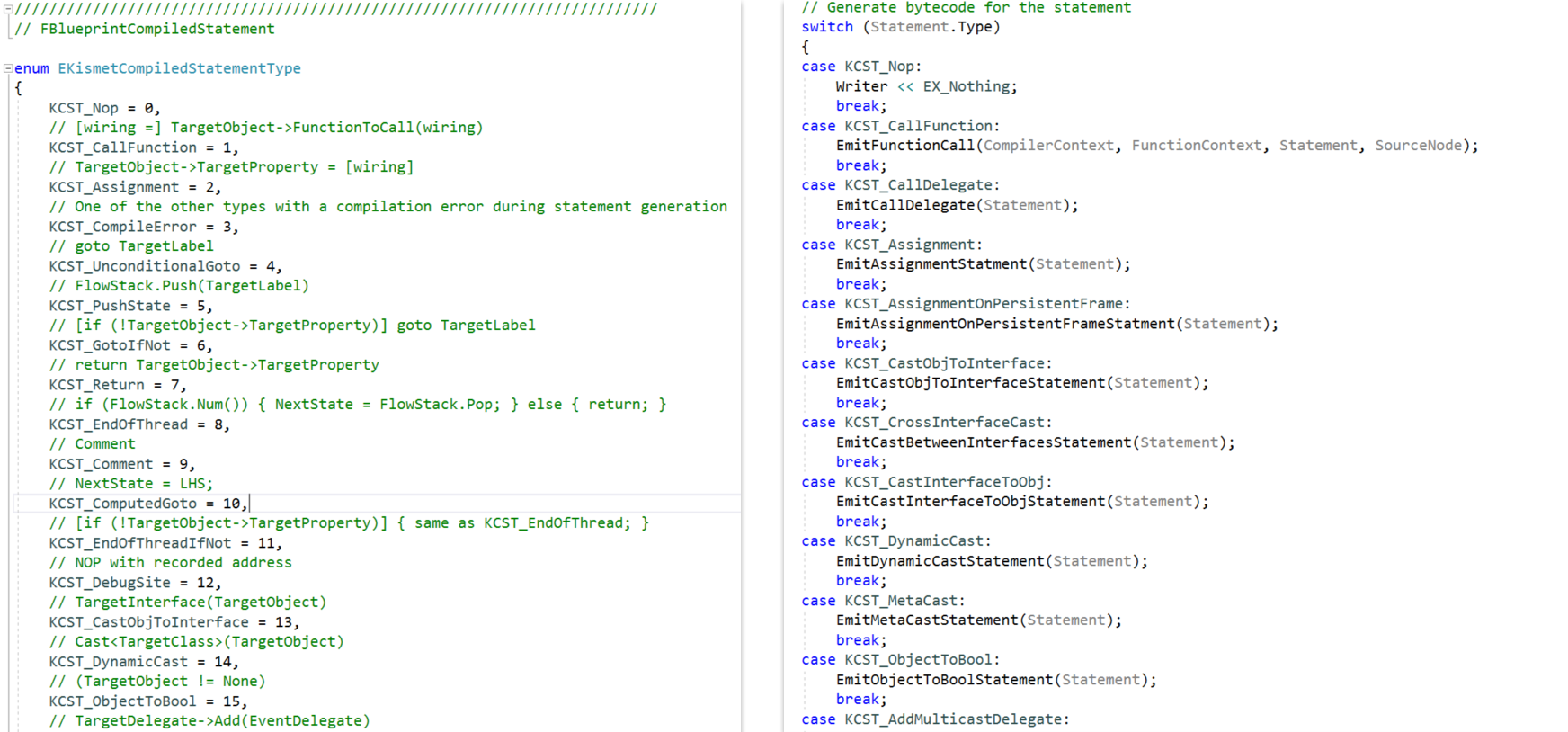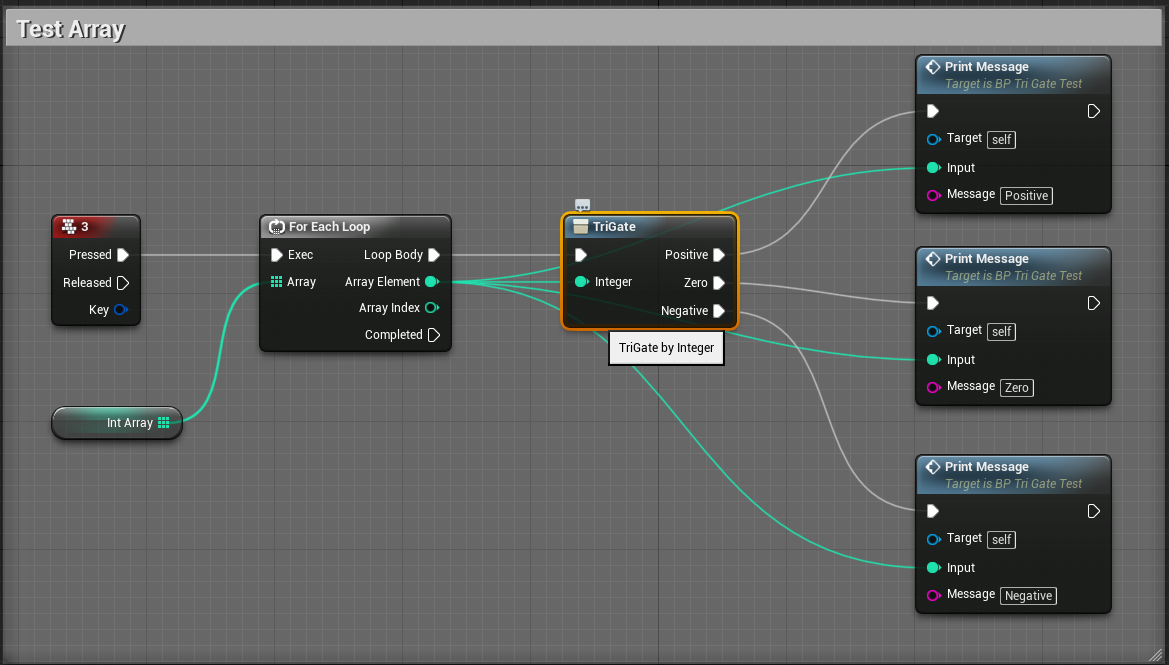内容概要
前面两篇博客我们都是通过ExpandNode来实现蓝图节点的功能,这一篇来介绍另外一种重要的蓝图扩展方式,就是Node Handler。
【欢迎转载,请注明作者:房燕良,原文出处:游戏程序员的自我修养】
通过前面的文章,我们已经能够创建自己的蓝图节点,并可以动态添加、删除Pins,但是感觉好像有什么地方不太对劲啊。你发现没有?那就是前面两篇文章中,我们自定义的蓝图节点都是通过UK2Node::ExpandNode()来实现节点的具体功能,然而,这个函数只不过是在内部创建了一些其他的节点,然后把自己的Pins重新连接到新建的节点的Pin之上,本质上这个过程手动连线也可以做啊!如果,我们需要做一个全新的蓝图功能节点,无法用现有节点组合完成呢?那要怎么办呢?那就需要深入到蓝图的编译过程,控制蓝图编译出的字节码,来实现想要的节点功能了。引擎中实现的大多数默认节点都是这样做的。在这篇博客,就通过一个最简单的实例,来探索这个过程是怎么实现的。
在进入实做的细节之前,我们必须先谈一点概念性的抽象的东西,概念搞明白了之后,我们再通过一个实例来看一下具体的实现步骤。
浅谈蓝图编译过程
由于本人对蓝图编译的过程掌握的还不够,还不能非常详实的把它的原理和实现都说的很明白,所以这里只能“浅谈”一下,谈个大概。在以后的博文中再进行补充吧。
- 蓝图编译过程的最终产出是一个:
UBlueprintGeneratedClass对象。UBlueprintGeneratedClass它是从UClass派生的,也就是说它具备Unreal C++开发的类所具备的那些UProperty啊、UFunction啊等等东西; - 蓝图里面使用可视化Graph编辑的那些逻辑,最终会生成字节码,保存到
UFunction成员变量中,具体就是:TArray<uint8>UFunction::Script这个成员变量啦; - 字节码生成的核心过程是
- 遍历Graph的所有节点,使用一定策略(具体是啥策略,另外的文章再讲)生成一个线性的列表,保存到“
TArray<UEdGraphNode*>FKismetFunctionContext::LinearExecutionList”; - 然后遍历每个蓝图节点,生成相应的“语句”,正确的名词是:Statement,保存到“
TMap< UEdGraphNode*, TArray<FBlueprintCompiledStatement*> > FKismetFunctionContext::StatementsPerNode”,一个Node在编译过程中可以产生多个Statement; 重点来了:这就是我们开发的自定义节点能够控制字节码生成的地方。 - Statement 有很多类型,看看它的枚举,发现很接近字节码了,是类似汇编语言那种;需要通过“条件跳转”之类的逻辑,在线性的代码中产生分支和循环;详见下图中的:
enum EKismetCompiledStatementType- 上述过程可以算是编译器的前端,接下来就进入后端的流程,具体代码是在:
classFKismetCompilerVMBackend; - 后端,也就是字节码的生成的核心代码是在:
FScriptBuilderBase::GenerateCodeForStatement(),这个函数通过一个大的“switch (Statement.Type)”语句,把不同类型的statement生成字节码
- 上述过程可以算是编译器的前端,接下来就进入后端的流程,具体代码是在:
- 遍历Graph的所有节点,使用一定策略(具体是啥策略,另外的文章再讲)生成一个线性的列表,保存到“

那么,在前面提到的“重点步骤”是怎么实现呢?很简单,分两步:
- 定义一个
class FNodeHandlingFunctor的派生类,重载其方法,例如:Compile()等,即可控制这个节点在编译过程中生成的statement; - 重载
class UK2Node的虚函数“CreateNodeHandler()”,返回一个上述派生类的对象指针。
FNodeHandlingFunctor 详解
既然本文重点步骤就是编写FNodeHandlingFunctor的派生类,那么有必要把这个基类仔细的看看啦!
这个类的代码并不多,但是包含了三个重要的概念:
- Statement:这个前面已经讲过了,它对应的是“
struct FBlueprintCompiledStatement”。这个结构体有很多变量,但是并不是同时有效的,具体要根据Type字段来解释。其中的LHS和RHS是两个常用的字段,也就是我们常说的“左值”和“右值”。(简单说就是:一个表达式把一系列右侧的参数值计算之后赋值给左侧的变量) - Terminal,也就是:struct FBPTerminal,它的注释说的比较明白:A terminal in the graph (literal or variable reference),也就是说“它代表Graph中的一个端点,可能是字面量,也可能是变量的引用”
- Net:对于“变量引用型的Terminal”,需要注册的一个“关系网”中,用来在运行时求解它的值。
理解了这三个概念之后,再来看他的几个常用的虚函数:
virtual void Compile(FKismetFunctionContext& Context, UEdGraphNode* Node)这个就是编译过程中的回调啦,一般用来生成这个Node对应的Statement,可以是0个到多个;-
virtual void RegisterNets(FKismetFunctionContext& Context, UEdGraphNode* Node)这个节点注册Terminal网络的回调;在这里可以使用“FKismetFunctionContext::CreateLocalTerminal”创建非Pin直接相关的Terminal对象; -
virtual void RegisterNet(FKismetFunctionContext& Context, UEdGraphPin* Pin)这个节点上的针脚注册Terminal网络的回调;
总结一下:
- 实现一个FNodeHandlingFunctor的派生类,我们可以实现自己的Node Handler
- 通过这个Node Handler,可以在编译过程中生成需要的Terminal,并注册到Net中
- 在编译的过程中,可以生成任意多个Statement,直接影响后续的字节码生成
举个栗子
下面我们就通过一个具体的例子,来看看通过Node Handler方式控制蓝图节点的编译,具体如何实现的。说实话,引擎实现的蓝图节点真的很丰富了,很难想出一个有实用性的例子,只好胡诌一个了:
- 判断输入的一个整型变量,分为:正数,零,负数,三种状态,执行不同的流程;
如下图中的“TriGate”节点所示:

完整的Demo工程可以从我的GitHub下载:https://github.com/neil3d/UnrealCookBook/tree/master/MyBlueprintNode
这个节点的完整源代码附在文末,我们先来step by step讲解一下,实现过程不难理解:
第一步:添加一个自定义的UK2Node派生类
首先就是要创建一个class UK2Node的派生类:class UBPNode_TriGate : public UK2Node,这个过程很简单,基本上和前面两篇博客介绍的一样,这里就不重复了。只有一个地方不同,那就是我们不再需要重载 ExpendNode() 函数,而是重载CreateNodeHandler()函数。它的实现也很简单,就是返回一个我们自定义的FNodeHandlingFunctor派生类对象。
FNodeHandlingFunctor * UBPNode_TriGate::CreateNodeHandler(FKismetCompilerContext & CompilerContext) const
{
return new FKCHandler_TriGate(CompilerContext);
}
在其cpp文件中创建一个自定义的FNodeHandlingFunctor派生类:class FKCHandler_TriGate : public FNodeHandlingFunctor,后面将主要实现这个类的几个虚函数,来完成整个节点的功能。
第二步:生成两个Terminal
想象一下,代码执行过程中,我们需要比较输入的那个整数是否大于零,把结果保存到一个临时变量中,所以我们需要两个Terminal:
- 一个用来用来表示字面量“0”
- 另一个用来存储比较结果
这两个Terminal就是在”FKCHandler_TriGate::RegisterNets()”函数中定义的
virtual void RegisterNets(FKismetFunctionContext& Context, UEdGraphNode* Node) override
{
FNodeHandlingFunctor::RegisterNets(Context, Node);
// 存储比较结果的bool变量
FBPTerminal* BoolTerm = Context.CreateLocalTerminal();
BoolTerm->Type.PinCategory = UEdGraphSchema_K2::PC_Boolean;
BoolTerm->Source = Node;
BoolTerm->Name = Context.NetNameMap->MakeValidName(Node) + TEXT("_CmpResult");
BoolTermMap.Add(Node, BoolTerm);
// 字面量“0”
LiteralZeroTerm = Context.CreateLocalTerminal(ETerminalSpecification::TS_Literal);
LiteralZeroTerm->bIsLiteral = true;
LiteralZeroTerm->Type.PinCategory = UEdGraphSchema_K2::PC_Int;
LiteralZeroTerm->Name = TEXT("0");
}
第三步:实现Compile过程,生成6个Statement
做好了前面两步的准备,接下来就是关键的步骤了:定义一系列Statements来实现我们的逻辑。重复一下要实现的逻辑:
- 判断输入的一个整型变量,分为:正数,零,负数,三种状态,执行不同的流程;
逻辑很简单,不过,我们需要转换一下思考方式,要使用类似汇编语言的那种思路:要把语句顺序排列,然后使用条件跳转语句控制分支逻辑。下面将要使用到的Statement类型先说明一下:
- KCST_CallFunction:调用指定的UFunction,我们需要把“输入那个整数”和零做比较,这个功能我们将通过调用 class UKismetMathLibrary 中的函数来实现,使用到两个函数:
- UKismetMathLibrary::Greater_IntInt()
- UKismetMathLibrary::EqualEqual_IntInt()
- KCST_GotoIfNot:条件跳转,可以指定跳转到哪个Statement(或者指定的Pin);
- KCST_UnconditionalGoto:无条件跳转,主要用来跳转到右侧的三个Exec Pin中的一个;
KCST_CallFunction 实例
下面说一下KCST_CallFunction具体在我们这个例子中的使用。
首先我们需要找到UFunction相关的信息:
UClass* MathLibClass = UKismetMathLibrary::StaticClass();
UFunction* CreaterFuncPtr = FindField<UFunction>(MathLibClass, "Greater_IntInt");
UFunction* EqualFuncPtr = FindField<UFunction>(MathLibClass, "EqualEqual_IntInt");
下面生成的这个Statement就是比较输入变量是否大于零,并把比较结果保存到我们定义的BoolTerm变量中:
FBlueprintCompiledStatement& CallCreaterZero = Context.AppendStatementForNode(MyNode);
CallCreaterZero.Type = KCST_CallFunction;
CallCreaterZero.FunctionToCall = CreaterFuncPtr;
CallCreaterZero.LHS = BoolTerm;
CallCreaterZero.RHS.Add(InputTerm);
CallCreaterZero.RHS.Add(LiteralZeroTerm);
KCST_GotoIfNot 实例
下面生成的这个Statement就是通过判断BoolTerm的值为False的话,则跳转:
FBlueprintCompiledStatement& IfPositive = Context.AppendStatementForNode(Node);
IfPositive.Type = KCST_GotoIfNot;
IfPositive.LHS = BoolTerm;
那么,跳转到什么地方呢?跳转到后面的比较语句,具体代码如下:
FBlueprintCompiledStatement& CallEqualZero = Context.AppendStatementForNode(MyNode);
...
CallEqualZero.bIsJumpTarget = true;
IfPositive.TargetLabel = &CallEqualZero;
设置新的语句“bIsJumpTarget = true”,使它成为一个跳转的目标,然后把前面那个跳转的Statement的TargetLabel设置为这个新的语句。
KCST_UnconditionalGoto
无条件跳转到指定的Exec Pin。注意:下面这个Statement在运行时,根据BoolTerm的值,可能被前面的条件跳转语句跳过,来实现分支的逻辑。
FBlueprintCompiledStatement& ExecZero = Context.AppendStatementForNode(Node);
ExecZero.Type = KCST_UnconditionalGoto;
Context.GotoFixupRequestMap.Add(&ExecZero, ZeroPin);
完整的 Statement 列表
运用上面三种Statement,把他们罗列出来,即可实现我们的逻辑功能了。乍看上去可能并不直观,主要是这种类似汇编的方式并不直观,可能需要反复看几遍。
virtual void Compile(FKismetFunctionContext& Context, UEdGraphNode* Node) override
{
UBPNode_TriGate* MyNode = CastChecked<UBPNode_TriGate>(Node);
// 查找输入的那个整数的Pin对应的Terminal
UEdGraphPin* InputPin = Context.FindRequiredPinByName(Node, TriGatePN::Input, EGPD_Input);
UEdGraphPin* PinToTry = FEdGraphUtilities::GetNetFromPin(InputPin);
FBPTerminal** pInputTerm = Context.NetMap.Find(PinToTry);
if (pInputTerm == nullptr)
{
CompilerContext.MessageLog.Error(TEXT("FKCHandler_TriGate: Failed to resolve term passed into"), InputPin);
return;
}
FBPTerminal* InputTerm = *pInputTerm;
// 查找三个输出Pin
UEdGraphPin* PositivePin = MyNode->FindPin(TriGatePN::Positive, EGPD_Output);
UEdGraphPin* ZeroPin = MyNode->FindPin(TriGatePN::Zero, EGPD_Output);
UEdGraphPin* NegativePin = MyNode->FindPin(TriGatePN::Negative, EGPD_Output);
// 临时bool变量的Terminal
FBPTerminal* BoolTerm = BoolTermMap.FindRef(MyNode);
UClass* MathLibClass = UKismetMathLibrary::StaticClass();
UFunction* CreaterFuncPtr = FindField<UFunction>(MathLibClass, "Greater_IntInt");
UFunction* EqualFuncPtr = FindField<UFunction>(MathLibClass, "EqualEqual_IntInt");
// Statement 1: 计算表达式 BoolTerm = Interger > 0
FBlueprintCompiledStatement& CallCreaterZero = Context.AppendStatementForNode(MyNode);
CallCreaterZero.Type = KCST_CallFunction;
CallCreaterZero.FunctionToCall = CreaterFuncPtr;
CallCreaterZero.LHS = BoolTerm;
CallCreaterZero.RHS.Add(InputTerm);
CallCreaterZero.RHS.Add(LiteralZeroTerm);
// Statement 2: if(BoolTerm)
FBlueprintCompiledStatement& IfPositive = Context.AppendStatementForNode(Node);
IfPositive.Type = KCST_GotoIfNot;
IfPositive.LHS = BoolTerm;
// Statement 3: 执行 Positive Pin
FBlueprintCompiledStatement& ExecPositive = Context.AppendStatementForNode(Node);
ExecPositive.Type = KCST_UnconditionalGoto;
Context.GotoFixupRequestMap.Add(&ExecPositive, PositivePin);
// Statement 4: 计算表达式 BoolTerm = Interger == 0
FBlueprintCompiledStatement& CallEqualZero = Context.AppendStatementForNode(MyNode);
CallEqualZero.Type = KCST_CallFunction;
CallEqualZero.FunctionToCall = EqualFuncPtr;
CallEqualZero.LHS = BoolTerm;
CallEqualZero.bIsJumpTarget = true;
CallEqualZero.RHS.Add(InputTerm);
CallEqualZero.RHS.Add(LiteralZeroTerm);
IfPositive.TargetLabel = &CallEqualZero;
// Statement 5: GotoIfNot(BoolTerm)
FBlueprintCompiledStatement& IfZero = Context.AppendStatementForNode(Node);
IfZero.Type = KCST_GotoIfNot;
IfZero.LHS = BoolTerm;
Context.GotoFixupRequestMap.Add(&IfZero, NegativePin);
// Statement 6: 执行 Zero Pin
FBlueprintCompiledStatement& ExecZero = Context.AppendStatementForNode(Node);
ExecZero.Type = KCST_UnconditionalGoto;
Context.GotoFixupRequestMap.Add(&ExecZero, ZeroPin);
}
附:class UBPNode_TriGate源代码
- BPNode_TriGate.h
#pragma once
#include "CoreMinimal.h"
#include "K2Node.h"
#include "BPNode_TriGate.generated.h"
UCLASS()
class MYBLUEPRINTNODEEDITOR_API UBPNode_TriGate : public UK2Node
{
GENERATED_BODY()
public:
// UEdGraphNode interface
virtual void AllocateDefaultPins() override;
virtual FText GetTooltipText() const override { return FText::FromString(TEXT("TriGate by Integer")); }
virtual FText GetNodeTitle(ENodeTitleType::Type TitleType) const override { return FText::FromString(TEXT("TriGate")); }
// End of UEdGraphNode interface
// UK2Node interface
virtual FText GetMenuCategory() const { return FText::FromString(TEXT("MyBlueprintNodes")); }
virtual void GetMenuActions(FBlueprintActionDatabaseRegistrar& ActionRegistrar) const override;
virtual class FNodeHandlingFunctor* CreateNodeHandler(class FKismetCompilerContext& CompilerContext) const;
// End of UK2Node interface
};
- BPNode_TriGate.cpp
#include "BPNode_TriGate.h"
#include "EdGraphSchema_K2.h" // BlueprintGraph
#include "BlueprintNodeSpawner.h" // BlueprintGraph
#include "BlueprintActionDatabaseRegistrar.h" // BlueprintGraph
#include "BPTerminal.h"
#include "KismetCompilerMisc.h"
#include "KismetCompiler.h"
#include "Kismet/KismetMathLibrary.h"
#include "EdGraphUtilities.h"
namespace TriGatePN
{
FName Input = TEXT("Integer");
FName Positive = TEXT("Positive");
FName Zero = TEXT("Zero");
FName Negative = TEXT("Negative");
}
class FKCHandler_TriGate : public FNodeHandlingFunctor
{
protected:
// 为每个Node开辟一个临时bool变量,用来存储输入参数的比较结果
TMap<UEdGraphNode*, FBPTerminal*> BoolTermMap;
FBPTerminal* LiteralZeroTerm;
public:
FKCHandler_TriGate(FKismetCompilerContext& InCompilerContext)
: FNodeHandlingFunctor(InCompilerContext)
{
}
virtual void RegisterNets(FKismetFunctionContext& Context, UEdGraphNode* Node) override
{
FNodeHandlingFunctor::RegisterNets(Context, Node);
FBPTerminal* BoolTerm = Context.CreateLocalTerminal();
BoolTerm->Type.PinCategory = UEdGraphSchema_K2::PC_Boolean;
BoolTerm->Source = Node;
BoolTerm->Name = Context.NetNameMap->MakeValidName(Node) + TEXT("_CmpResult");
BoolTermMap.Add(Node, BoolTerm);
LiteralZeroTerm = Context.CreateLocalTerminal(ETerminalSpecification::TS_Literal);
LiteralZeroTerm->bIsLiteral = true;
LiteralZeroTerm->Type.PinCategory = UEdGraphSchema_K2::PC_Int;
LiteralZeroTerm->Name = TEXT("0");
}
virtual void Compile(FKismetFunctionContext& Context, UEdGraphNode* Node) override
{
UBPNode_TriGate* MyNode = CastChecked<UBPNode_TriGate>(Node);
// 查找输入的那个整数的Pin对应的Terminal
UEdGraphPin* InputPin = Context.FindRequiredPinByName(Node, TriGatePN::Input, EGPD_Input);
UEdGraphPin* PinToTry = FEdGraphUtilities::GetNetFromPin(InputPin);
FBPTerminal** pInputTerm = Context.NetMap.Find(PinToTry);
if (pInputTerm == nullptr)
{
CompilerContext.MessageLog.Error(TEXT("FKCHandler_TriGate: Failed to resolve term passed into"), InputPin);
return;
}
FBPTerminal* InputTerm = *pInputTerm;
// 查找三个输出Pin
UEdGraphPin* PositivePin = MyNode->FindPin(TriGatePN::Positive, EGPD_Output);
UEdGraphPin* ZeroPin = MyNode->FindPin(TriGatePN::Zero, EGPD_Output);
UEdGraphPin* NegativePin = MyNode->FindPin(TriGatePN::Negative, EGPD_Output);
// 临时bool变量的Terminal
FBPTerminal* BoolTerm = BoolTermMap.FindRef(MyNode);
UClass* MathLibClass = UKismetMathLibrary::StaticClass();
UFunction* CreaterFuncPtr = FindField<UFunction>(MathLibClass, "Greater_IntInt");
UFunction* EqualFuncPtr = FindField<UFunction>(MathLibClass, "EqualEqual_IntInt");
// Statement 1: 计算表达式 BoolTerm = Interger > 0
FBlueprintCompiledStatement& CallCreaterZero = Context.AppendStatementForNode(MyNode);
CallCreaterZero.Type = KCST_CallFunction;
CallCreaterZero.FunctionToCall = CreaterFuncPtr;
CallCreaterZero.LHS = BoolTerm;
CallCreaterZero.RHS.Add(InputTerm);
CallCreaterZero.RHS.Add(LiteralZeroTerm);
// Statement 2: if(BoolTerm)
FBlueprintCompiledStatement& IfPositive = Context.AppendStatementForNode(Node);
IfPositive.Type = KCST_GotoIfNot;
IfPositive.LHS = BoolTerm;
// Statement 3: 执行 Positive Pin
FBlueprintCompiledStatement& ExecPositive = Context.AppendStatementForNode(Node);
ExecPositive.Type = KCST_UnconditionalGoto;
Context.GotoFixupRequestMap.Add(&ExecPositive, PositivePin);
// Statement 4: 计算表达式 BoolTerm = Interger == 0
FBlueprintCompiledStatement& CallEqualZero = Context.AppendStatementForNode(MyNode);
CallEqualZero.Type = KCST_CallFunction;
CallEqualZero.FunctionToCall = EqualFuncPtr;
CallEqualZero.LHS = BoolTerm;
CallEqualZero.bIsJumpTarget = true;
CallEqualZero.RHS.Add(InputTerm);
CallEqualZero.RHS.Add(LiteralZeroTerm);
IfPositive.TargetLabel = &CallEqualZero;
// Statement 5: GotoIfNot(BoolTerm)
FBlueprintCompiledStatement& IfZero = Context.AppendStatementForNode(Node);
IfZero.Type = KCST_GotoIfNot;
IfZero.LHS = BoolTerm;
Context.GotoFixupRequestMap.Add(&IfZero, NegativePin);
// Statement 6: 执行 Zero Pin
FBlueprintCompiledStatement& ExecZero = Context.AppendStatementForNode(Node);
ExecZero.Type = KCST_UnconditionalGoto;
Context.GotoFixupRequestMap.Add(&ExecZero, ZeroPin);
}
};
void UBPNode_TriGate::AllocateDefaultPins()
{
CreatePin(EGPD_Input, UEdGraphSchema_K2::PC_Exec, UEdGraphSchema_K2::PN_Execute);
CreatePin(EGPD_Input, UEdGraphSchema_K2::PC_Int, TriGatePN::Input);
CreatePin(EGPD_Output, UEdGraphSchema_K2::PC_Exec, TriGatePN::Positive);
CreatePin(EGPD_Output, UEdGraphSchema_K2::PC_Exec, TriGatePN::Zero);
CreatePin(EGPD_Output, UEdGraphSchema_K2::PC_Exec, TriGatePN::Negative);
}
void UBPNode_TriGate::GetMenuActions(FBlueprintActionDatabaseRegistrar& ActionRegistrar) const
{
UClass* ActionKey = GetClass();
if (ActionRegistrar.IsOpenForRegistration(ActionKey))
{
UBlueprintNodeSpawner* NodeSpawner = UBlueprintNodeSpawner::Create(GetClass());
check(NodeSpawner != nullptr);
ActionRegistrar.AddBlueprintAction(ActionKey, NodeSpawner);
}
}
FNodeHandlingFunctor * UBPNode_TriGate::CreateNodeHandler(FKismetCompilerContext & CompilerContext) const
{
return new FKCHandler_TriGate(CompilerContext);
}